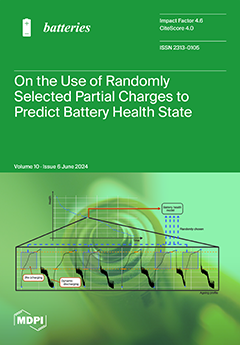Supercapacitors have long suffered from low energy density. Here, we present a high-energy, high-safety, and temperature-adaptable aqueous proton battery utilizing two-dimensional Ti
3C
2T
x MXenes as anode materials. Additionally, our work aims to provide further insights into the energy storage
[...] Read more.
Supercapacitors have long suffered from low energy density. Here, we present a high-energy, high-safety, and temperature-adaptable aqueous proton battery utilizing two-dimensional Ti
3C
2T
x MXenes as anode materials. Additionally, our work aims to provide further insights into the energy storage mechanism of Ti
3C
2T
x in acid electrolytes. Our findings reveal that the ion transport mechanism of Ti
3C
2T
x remains consistent in both H
2SO
4 and H
3PO
4 electrolytes. The mode of charge transfer depends on its terminal groups. Specifically, the hydrogen bonding network formed by water molecules adsorbed by hydroxyl functional groups under van der Waals forces enables charge transfer in the form of naked H
+ through the Grotthuss mechanism. In contrast, the hydrophobic channel formed by oxygen and halogen terminal groups facilitates rapid charge transfers in the form of hydronium ion via the vehicle mechanism, owing to negligible interfacial effect. Herein, we propose an aqueous proton battery based on porous hydroxy-poor Ti
3C
2T
x MXene anode and pre-protonated Cu
II[Fe
III(CN)
6]
2/3∙4H
2O (H-TBA) cathode in a 9.5 M H
3PO
4 solution. This proton battery operates through hydrated H
+/H
+ transfer, leading to good electrochemical performance, as evidenced by 26 Wh kg
−1 energy density and 162 kW kg
−1 power density at room temperature and an energy density of 17 Wh kg
−1 and a power density of 7.4 kW kg
−1 even at −60 °C.
Full article





